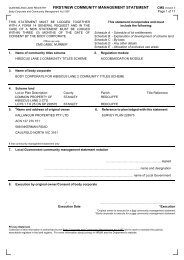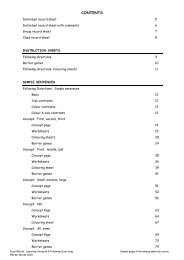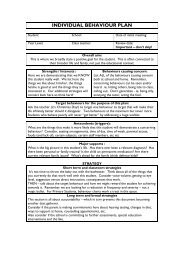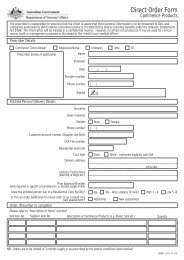Understanding rural landholder responses to climate change
Understanding rural landholder responses to climate change
Understanding rural landholder responses to climate change
- No tags were found...
Create successful ePaper yourself
Turn your PDF publications into a flip-book with our unique Google optimized e-Paper software.
The locationThe NCCMA region is situated in north central Vic<strong>to</strong>ria, extending from the MurrayRiver in the north <strong>to</strong> the Great Divide in the south, and from the Mt Camel Range inthe east <strong>to</strong> the western boundary of the Avon-Richardson catchment in the west. Witha population of over 200,000 and a diverse agricultural sec<strong>to</strong>r, much of the land ismanaged privately, and has been cleared. The natural habitat is fragmented,particularly on the flat plains <strong>to</strong> the north of Bendigo. Two case study areas wereselected for this research, the Kamarooka zone located <strong>to</strong> the north of Bendigo and theMuckleford zone <strong>to</strong> the south. The Kamarooka zone encompasses flat plain and gentlehill country north of Bendigo, while the Muckleford zone broadly encompasses thehilly country <strong>to</strong> the south of Bendigo between the Campaspe and Loddon Rivers.Research approachWith assistance from local NRM stakeholders, interview participants were selected <strong>to</strong>provide broad coverage of <strong>landholder</strong>s with different characteristics (age, gender, landuse type including farmers and non-farmers, dependence on farm income, permanentresidents and „absentee‟ <strong>landholder</strong>s, time on property and so on).Face-<strong>to</strong> face interviews with <strong>landholder</strong>s were organised around a small number ofbroad <strong>to</strong>pics, with a number of probing questions <strong>to</strong> explore <strong>to</strong>pics in greater depth.These <strong>to</strong>pics explored the major <strong>change</strong>s in property management over the past 10years and future challenges.The field research was undertaken by a team of six in early March 2008. Thirty-sixinterviews were completed with 18 in each zone, with each interview taking onaverage a little over one hour. Interview transcripts were typically from two <strong>to</strong> eightpages in length. Data analysis involved a process of content analysis, wherebysections of text are coded according <strong>to</strong> themes identified either from the literaturereview, or from the interview data. As data is gathered in<strong>to</strong> themes, common andcontradic<strong>to</strong>ry elements are identified <strong>to</strong> link themes, explain patterns and ultimately <strong>to</strong>develop theory <strong>to</strong> respond <strong>to</strong> the research questions.There were important differences in the characteristics of interviewees in Mucklefordand Kamarooka. Properties in the Kamarooka zone were larger on average, andinterviewees were more likely <strong>to</strong> be involved in cropping and have multipleenterprises on their properties. While there was a greater diversity of land uses acrossthe Muckleford area, there was a higher proportion of specialised or single enterpriseproperties, and of smaller „lifestyle‟ properties. Informants in the Muckleford zonewere almost a decade older than those in the Kamarooka zone. In both areas themajority of informants were farmers by occupation, though there was a much higherproportion of non-farmers amongst those interviewed in the Muckleford Zone.Key findingsThe range of <strong>responses</strong> <strong>to</strong> <strong>climate</strong> variability by <strong>rural</strong> <strong>landholder</strong>sThe <strong>landholder</strong>s interviewed were making a conscious effort <strong>to</strong> cope with reducedrainfall and water availability. These <strong>responses</strong> include identifying new watersupplies such as groundwater bores, capturing more surface water (by cleaning outand expanding dams, and installing tanks), and improving water use efficiency (byinstalling pipes and troughs, and in some cases adopting minimum till practices <strong>to</strong>iv
















